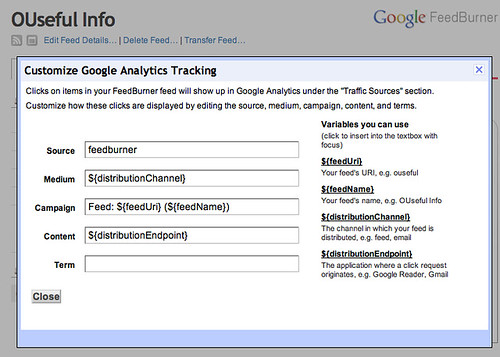Over the last couple of weeks, it seems as if the Goog has been doing a bit of reconciliation on the old analytics front, in particular the ability to track traffic driven back to your website from links contained within a feed published from that site using Feedburner…
The first thing I’d noticed as being different was the appearance Google Analytics tracking codes on Feedburner powered posts that I was reading in Google Reader – opening such a post in a new window seems to display it with a set full blown set of GA tracking attributes. So for example, opening a post from the Feedburnered OUsful.Info feed results in a URI like this:
http://ouseful.wordpress.com/2009/11/18/under-the-radar/?
utm_source=feedburner&utm_medium=feed
&utm_campaign=Feed%3A+ouseful+%28OUseful+Info%29&utm_content=Google+Reader
…and I’m pretty sure I didn’t put those tracking codes in there explicitly…
In “Campaign” Tracking With Google Analytics, I started sketching out how it might be possible to use Google Analytics campaign tracking codes to to track the spread of referrer links to documents or document fragments hosted on WriteToReply or JISCPress, so let’s see how the Feedburner annoations are structured:
- utm_source=feedburner (that is, the originator of the feed);
- utm_medium=feed (that is, the means by which the content was transported/syndicated);
- utm_campaign=Feed: ouseful (OUseful Info) (that is, the name of the Feedburner feed (I think: the feed URL is http://feedburner.com/ouseful), followed by the feed title (OUseful Info);
- utm_content=Google Reader (that is, the place where I viewed the link).
Compare this with the suggestion I made for annotating WriteToReply links:
- utm_source=twitter.com (that is, the place a link was ‘launched’);
- utm_medium=question (that is, the type of slug content used to qualify the link);
- utm_campaign=jiscri (that is, the consultation document linked to, e.g. for the link <em.http://writetoreply.org/jiscri/2009/03/11/rapid-innovation-projects/);
- utm_content=slug3 (that is, a unique ID to identify the text used to qualify the syndicated link).
So how can you get Googalytics tracking codes on your Feedburner feeds? Details are still sketchy, (e.g. see the original announcement on the Goole Analytics blog here: An Integration With Feedburner, and the Google AdSense for Feeds blog here: “Afternoon, Frank.” “Hey howdy, George.”) but this Google FAQ post on How do I set up my FeedBurner feed to report feed clicks in Google Analytics?:
If you use Google Analytics to track web site visitors, you can see feed clicks originating from your FeedBurner feed by activating an option on the Analyze tab.
When someone clicks one of your feed items and ends up back on your web site, Google Analytics will track that activity and include it in the “Traffic Sources” section.
The post also tells you where you can set up the tracking details – from the Configure Stats menu option. And selecting that, I can now see why my feed links are annotated as they are:
(I’m not sure how the $distributionEndpoint is treated for none Google properties?)
The Google AdSense for Feeds post suggests that:
By default, these analytics will show up in the “All Traffic Sources” and “Campaigns” views in Google Analytics. You can filter the results just to only the traffic that comes from Google FeedBurner by filtering on “feedburner” on the All Traffic Sources page or “Feed:” on the campaigns view. You can also use these sources in the Advanced Segments views.
which suggests that for sites like JISCPress/WriteToReply that use Google Analytics on the main site and Feedburner for the public/promoted feeds, the Feedburner integration will automatically annotate feed links with tracking codes that can be tracked from the site’s Google Analytics dashboard.

One Reply to “Google Analytics, Feedburner and Google Reader”
Comments are closed.